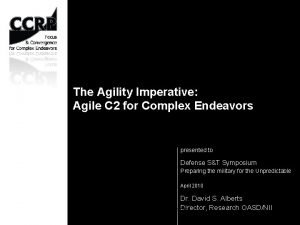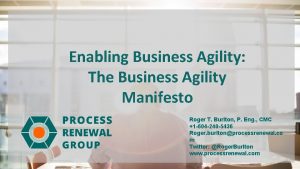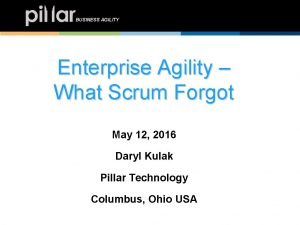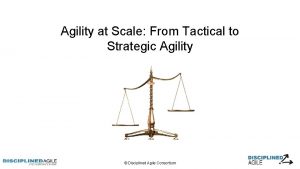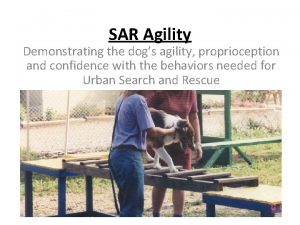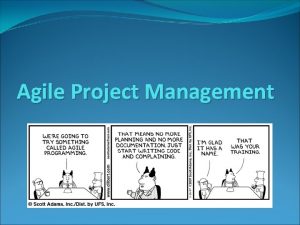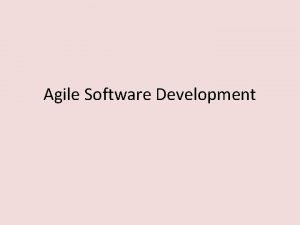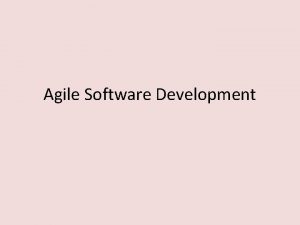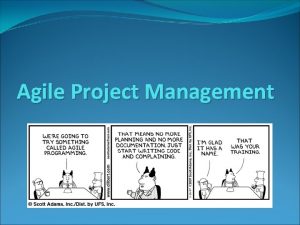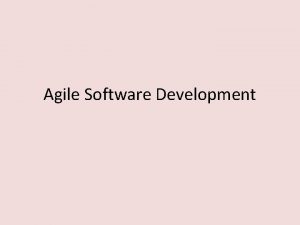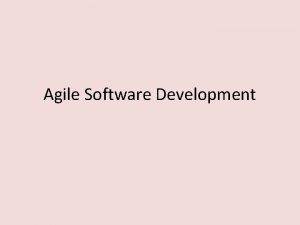The Agile Paradox Agility to manage complex programs




















- Slides: 20

The Agile Paradox Agility to manage complex programs, while adding (social) complexity PGMopen 2016 Dr. Mr. Ben Berndt MBA-FSI Head of CPMO NN Group CPMO: Pool of program managers Portfolio management Quality assurance Financial planning & Control Lean Six Sigma Training facilities Member of Glocomnet ISCE Research

Presentation storyline • A little disclaimer; it’s my personal reflection; no science • Agile & self-organization • Agility to manage complexity in programs § Both on program level and on project(s) level • But what is complexity (and complicatedness) • (get) PM (back) in the ideal complicated (management) domain (simplification) • Management of complex programs • Management of uncertainty • Management of social complexity (paradox)

Agile & Self-Organization § Remington and Pollack (2007) referring to “fast-track” state that these projects increase the level of complexity exponentially § Fewell, CST, PMP (2015): A true agile practitioner asks simple questions like: “are we all on the same page? ” Might not be that simple (BB); since that implicitly refers to perception and world views, which relates to systems theory and social (perceived complexity) § Nicholson (N Cubed Consulting, 2015): “Transforming your business into an “agile” one, (it) becomes a complex mix of methodologies, psychologies, disciplines and negotiations…” § Bloomberg (Forbes Tech 2015): “Agile calls for self-organizing teams, but there remains no clear understanding of how best to self-organize”

Agile & Self-Organization “Agile doesn’t mean total freedom, it means self-organization through some constraints says Henrique Imberti Jr. , PMP. When a garden is not being managed, it will keep growing, but in another direction than what was intended. We, as project managers, need to be gardeners and grow our teams as intended. ” This presentation’s topic: • But a garden is a map; it’s not the territory. A garden is already organized. • Gardens belong to the “safe” management domain. • That’s not were self-organization happens, that emerges in the territory itself, you -as an agile manager- should be able to contrarily let go direction, let it flow and interfere with caution; • to be able to handle uncertainty; that –in my perception BB- is what agile is about.

Manage complex programs Self-Organization = social complex What is Complexity Complicatedness? Complexity is the study of items which are more than just sum of their identifiable parts: a dead frog cannot be reassembled. So complex is not the same as complicated. We people can tackle complicatedness (via expertise), the complex we cannot really tackle, nor manage? q A Boeing 747 is (highly) complicated. q The weather, rainforests, traffic, social media, and a flog of seagulls are complex.

Manage complex programs Project Complexity; not much consensus q most writers refer to interrelatedness (many varied interrelated parts e. g. Baccarini). q Others refer to perceived complexity: complexity is labeled here as subjective: not all perceive the same problematical situation, nor can an observer perceive the whole context, nor do all perceive the same context (research by Chronéer & Bergquist, 2012). § Components plus interactions plus context plus interpretations form a complex whole. (ISCE Research, www. ISCE. edu)

Program complexity: NTCP Model (Shenhar & Dvir) Relationships Technology & Novelty & Pace make it (more) complex

Program complexity: Complexity Mapping (Remington & Pollack) Structural extreme: "We can't see the forest for the trees", "How can we keep track of all the interdependencies” Technically extreme: "How do we do or make it", "There is nothing like this out there” Directionally extreme: "How do we share understanding", "No one seems to be on the same page” Temporally extreme: "It is like standing on quicksand", "Everything keeps shifting”

Manage complex programs Complicated domain, ideal PM domain, that domain is all about management Try not to make it more complex (simplify) Unknown unknowns. Uncertainty. You need to let go, watch patterns. Oh this is what it is about (retro). Probe first. Agile PM. . . Known unknowns. Multiple answers. Expert domain. Sense: This could be about. Analyze. Ideal PM landscape? Agile, Waterfall, Hybrid Crisis. No patterns. Act. See what happens & respond Best Practice. Sense: This is what it is about. Categorize & respond. No PM needed? Retrieved from Snowden & Boone, A leader’s framework for decision making. HBR, Nov. 2007.

Manage complex programs Simplify Complexity reduction Retrieved (interpretation of) from Snowden & Boone, A leader’s framework for decision making. HBR, Nov. 2007. Laws of Simplicity (Meada 2006): § Reduce thoughtful. What do we really need § Organize (label, sort etc. ). Makes systems of many appear fewer § Time. Shorten the chain (LEAN) § Learn. Knowledge makes things simpler § Differences. find inherent simplicity (beautiful code) § Context. What is the meaning of all that beyond focus? § Emotion. Challenge your sensitivity § Trust. Omakaze: chef’s choice § Failure. Some things won’t get simpler § The one. Subtract the obvious and add the meaningful § Less is more § Openness § Move it far, far away (e. g. SAAS)

But it’s complex! Manage complex programs Complexity defined as uncertainty Management of uncertainty (1) • • • Uncertainty belongs to the managerial unwanted domain of “unknown-unknowns” (we just don’t know); a domain beyond risk management, risk you know, because you log them; don’t you? We PMs need to involve top management in the concept of uncertainty My idea is to add a complexity chapter to the project brief in which uncertainty is -implicitly - addressed

But it’s complex! Manage complex programs Complexity defined as uncertainty Management of uncertainty (2): • “Rules”: • • • Short term focus Iterative E. g. Act, Learn, Build model (Schlesinger, Kiefer, Brown, HBR 2012) Act: take a small step toward a goal Learn: evaluate the evidence you’ve created Build: repeat steps 1 and 2 until you accomplish goal • Use the means at hand • Stay within your acceptable loss or quit • Secure only the commitment you need for the next step • Bring along only volunteers • Link your move to a business imperative and produce early results • Manage expectations

But it’s complex! Manage complex programs Self-Organization APM’s guilds, squads, tribes, dailies, matrix add new social complexity Messy problems: people hold entirely different views on: § Whethere is a problem, § And if they agree there is, and; § What the problem is. “In that sense messy problems are quite intangible and as a result various authors (e. g. Checkland) have suggested that there are no objective problems, only situations defined as problems by people. Given the increasing complexity of the project teams and their operating environment more and more decisions of this type arise”. (Richardson, Tait, Roos, Lissack, 2005)

But it’s complex! Manage complex programs Self-Organization Let it flow, but interfere APM’s guilds, squads, tribes, dailies, matrix paradoxically add new social complexity; My toolkit: § (soft) systems theory § Learning Organization § wisdom of crowds…(diverse team) § social network § Dialogue § World Café § Roadmaps based on scenarios (planning) § Frameworks

But it’s complex! Manage complex programs APM’s guilds, squads, tribes, dailies, matrix paradoxically add new social complexity; my toolkit: Self-Organization Let it flow, but interfere § (soft) systems theory: bottom-up, circular, grounded change processes § Concept of the Learning Organization (team learning, personal mastery, focus on mental models, shared vision (strategy)

But it’s complex! Manage complex programs APM’s guilds, squads, tribes, dailies, matrix paradoxically add new social complexity; my toolkit: Self-Organization Let it flow, but interfere § Belief in the wisdom of crowds …but to make that work you need a diverse team: (Surowiecki, 2004) § Diversity of opinion (private info) § Independence (own opinion) § Decentralization (specialist, local knowledge) § Aggregation (be able to totalize) § And (BB) openness to outside knowledge and innovation; avoid knowledge to only circling internally

But it’s complex! Manage complex programs APM’s guilds, squads, tribes, dailies, matrix paradoxically add new social complexity; my toolkit: Self-Organization Let it flow, but interfere § Study the social network § Dialogue (generously listening to weak signals, background conversations, is something attracting the project? , significance of the project, what might “others” think? , how do we feel? ) § World Café approaches (participative planning) § Roadmaps based on scenarios (planning) functional / flexible § Frameworks should not rule; more structure means less contact with emergence

But it’s complex! Manage complex programs Leadership Interpreting Ashby's Law: more complexity requires a more varied control system. The more complex your project, the more “project steering variety” you need; certainly in the complex areas of your project. Outside Inside

But it’s complex! Manage complex programs Leadership • Not to judgmental to soon • You need (an) authentic person (people) • Authentic meaning: § § § Someone who seems vulnerable Is able to share with his/her team Listens to the team Is willing to change opinion But still is a decision taker This in -my view- does not align wit the PM capabilities that we assess today

“In some mysterious way woods have never seemed to me to be static things. In physical terms, I move through them; yet in metaphysical ones, they seem to move through me, just as, if I watch a film…” John Fowles, The Tree, 1979
 Hexagon agility test score clockwise
Hexagon agility test score clockwise Disadvantages of waterfall model in software engineering
Disadvantages of waterfall model in software engineering Oedipus complex and electra complex
Oedipus complex and electra complex Bruno dislikes sitting on the beach
Bruno dislikes sitting on the beach Carly's therapist asks her to simply
Carly's therapist asks her to simply Ghon complex and ranke complex
Ghon complex and ranke complex Sublimation psychology
Sublimation psychology Compound complex sentence quiz
Compound complex sentence quiz Gấu đi như thế nào
Gấu đi như thế nào Thẻ vin
Thẻ vin Thể thơ truyền thống
Thể thơ truyền thống Các châu lục và đại dương trên thế giới
Các châu lục và đại dương trên thế giới Từ ngữ thể hiện lòng nhân hậu
Từ ngữ thể hiện lòng nhân hậu Diễn thế sinh thái là
Diễn thế sinh thái là Ví dụ về giọng cùng tên
Ví dụ về giọng cùng tên Vẽ hình chiếu vuông góc của vật thể sau
Vẽ hình chiếu vuông góc của vật thể sau Frameset trong html5
Frameset trong html5 101012 bằng
101012 bằng Hươu thường đẻ mỗi lứa mấy con
Hươu thường đẻ mỗi lứa mấy con Lời thề hippocrates
Lời thề hippocrates Chụp phim tư thế worms-breton
Chụp phim tư thế worms-breton























